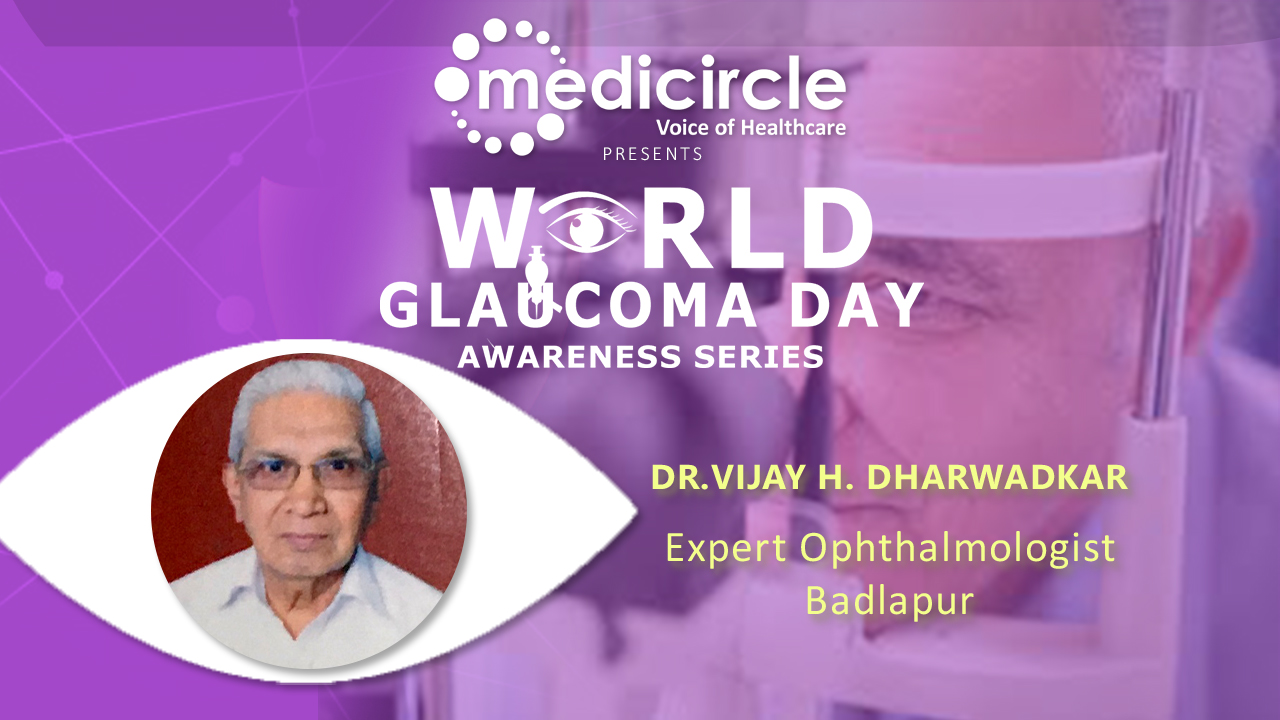The eyes are one of the most important senses. As age advances, preserving your vision must be of utmost importance. Loss of eyesight is one of the important concerns, especially in old age. Protecting your eyes will help reduce blindness and vision loss. A glaucoma is a group of eye conditions that damage the optic nerve, the health of which is vital for good vision. Combined with an aging population we can see an epidemic of blindness blooming if we don't raise awareness about the importance of regular eye examinations to preserve vision.
At Medicircle, we are conducting an awareness series on Glaucoma with Eminent Ophthalmologists for the World Glaucoma Day to boost awareness and educate people about eye health.
Dr.Vijay Dharwardkar is an Expert Ophthalmologist having consulting practice in Mumbai since 1970. With his rich clinical experience in the field of Ophthalmology, he is a pioneer in his field. Dr.Dharwadkar has five honorary attachments with many hospitals in Mumbai. He organized and attended more than 200 surgical cataract eye camps and performed thousands of cataract surgeries as a charity. He has established NGO by the name “Janmada Eye & Medical Foundation”(registered under Charity Commissioner) and actively participated in WHO Vision 2020 project
Understanding the anatomy and circulation of the eye is important
Dr.Vijay Dharwardkar says, “To understand the causes of blindness in Glaucoma, it is very essential to know the normal physiology of ocular drainage. Circulation of blood is a continuous process that provides nutrition to all parts of the body except one part of the eye which is completely devoid of blood supply.
There are many parts of the eye, which are as follows.
1.Conjunctiva
2.Cornea
3.Iris and Pupil
4.Lens
5.Vitreous
6.Retina
7.Choroid.
8.Macula
9.Optic nerve
10.Sclera
11.Eyelids
Increase in ocular pressure of the eye which causes Glaucoma
Dr. Dharwadkar informs, “Cornea is a transparent part of the eyeball as it is completely devoid of blood vessels. All other parts of the eye receive blood by the network of small blood vessels. For the nutrition of the cornea, there are special filters that allow only water ( Aqueous humor ) to reach the cornea and give nutrition. This water is very crystal clear which keeps the cornea moist and clear. We get clear vision as the cornea is devoid of blood vessels. When filters are not working properly, the water which is being continuously produced in the eye gets stagnated inside the eyeball. This increases the tension of the eye which is called Intraocular Pressure ( IOP). Like standard blood pressure, there is standard intraocular pressure and the normal IOP is 10 to 20 mmHg, maybe plus or minus 2. When the drainage system is affected, the water can not go out and gets accumulated inside the ball. But there is one weak point in the eyeball which lies in the Optic nerve. This optic nerve carries visual responses from eye to brain and vice versa. This nerve gets its blood supply through a blood vessel which enters the optic nerve in its center and supplies blood to all parts of the eye and forms the choroid plexus between the retina and Sclera. This entry point in the optic nerve becomes a weak point. This part of the optic nerve is called the optic nerve head. It is this point where there is a normal optic cup when the IOP is normal or not raised.”
The intraocular pressure damages the optic nerve in Glaucoma
Dr. Dharwadkar says, “When the ocular filters get blocked, the water (aqueous humor )has no way to go out, it starts pressing the optic nerve and it flows through the sheaths of the blood vessels. This causes pressure on optic nerve fibers and they are pressed, thus it causes deepening and or widening of the optic cup. The raised IOP compresses the blood vessel and reduces the blood supply of the optic nerve. This condition leads to atrophy of the optic nerve gradually.That's why in long-standing Glaucoma, the optic nerve head becomes white ( normally it is slightly pink ) which denotes total atrophy of the optic nerve. As the nerve is unable to carry visual impulses to and from the brain, the patient becomes blind, even the entire remaining eye structures are healthy or normal.”
Glaucoma is not reversible so a regular eye check after 40 is essential
Dr. Dharwadkar states, “Glaucoma is not reversible, but blindness can be prevented if diagnosed at an early stage. For this regular check-up by an Ophthalmologist for IOP, fundoscopy and field of vision after the age of 40 years is essential. Fatty, fertile, female in forties are most susceptible to Glaucoma. Treatment, in short, can be divided in medical and surgical, but none of them can be guaranteed for success in controlling IOP.”
(Edited by Dr.Rati Parwani)

 Insights about the physiology of the eye which helps us understand the real truth about Glaucoma, a devastating condition that can lead to blindness with Dr.Vijay Dharwardkar. Read ahead how Dr. Dharwardkar reveals the reality about glaucoma with his rich clinical experience.
Insights about the physiology of the eye which helps us understand the real truth about Glaucoma, a devastating condition that can lead to blindness with Dr.Vijay Dharwardkar. Read ahead how Dr. Dharwardkar reveals the reality about glaucoma with his rich clinical experience.










.jpeg)



.jpg)





.jpeg)

.jpg)





.png)

